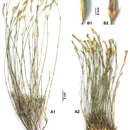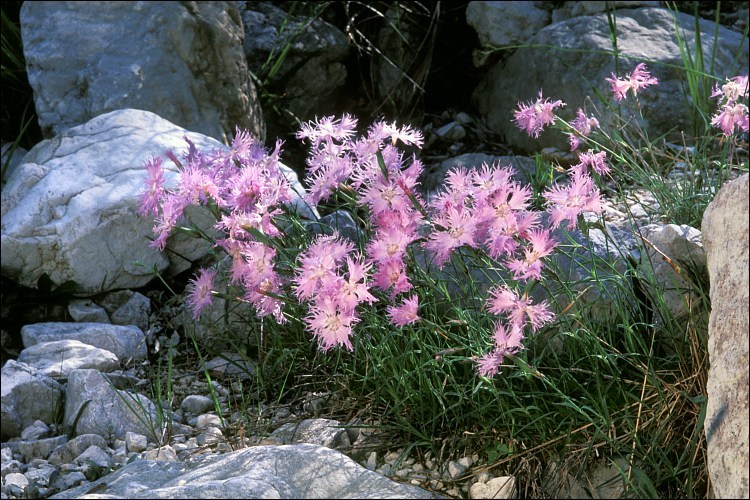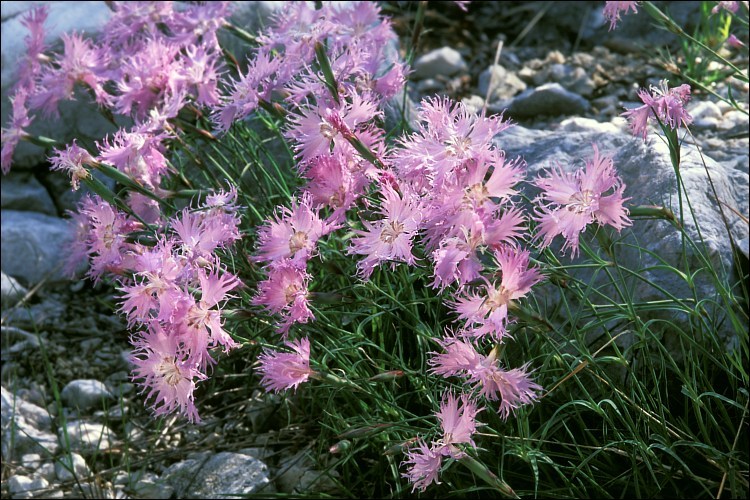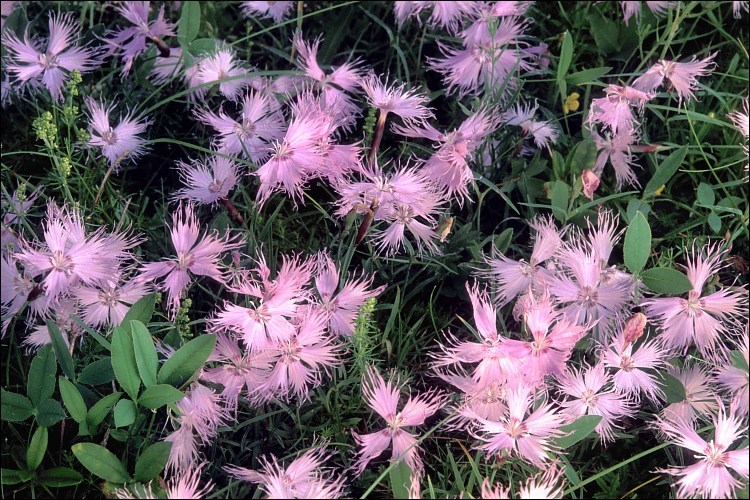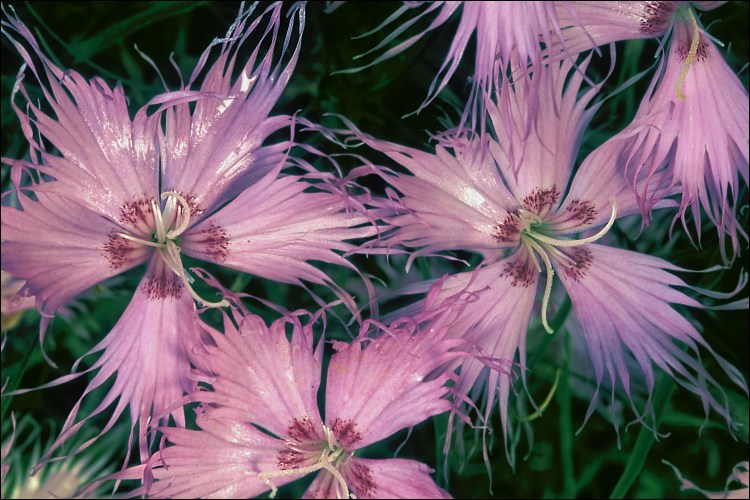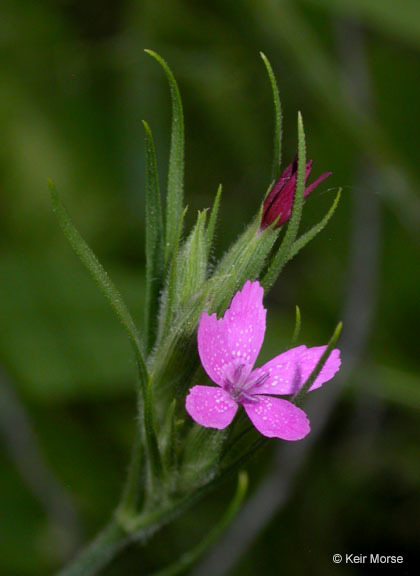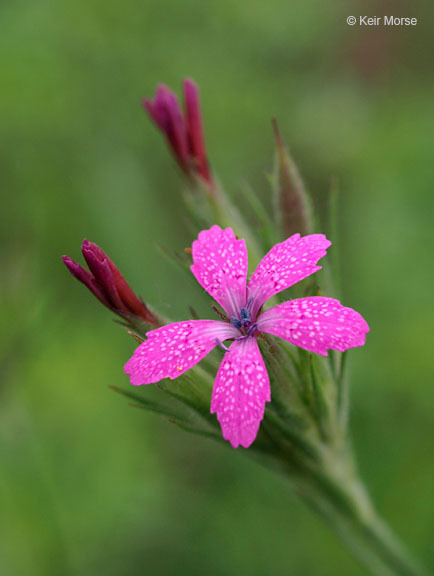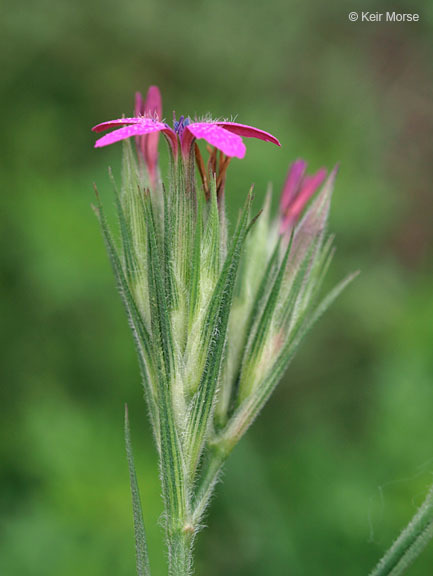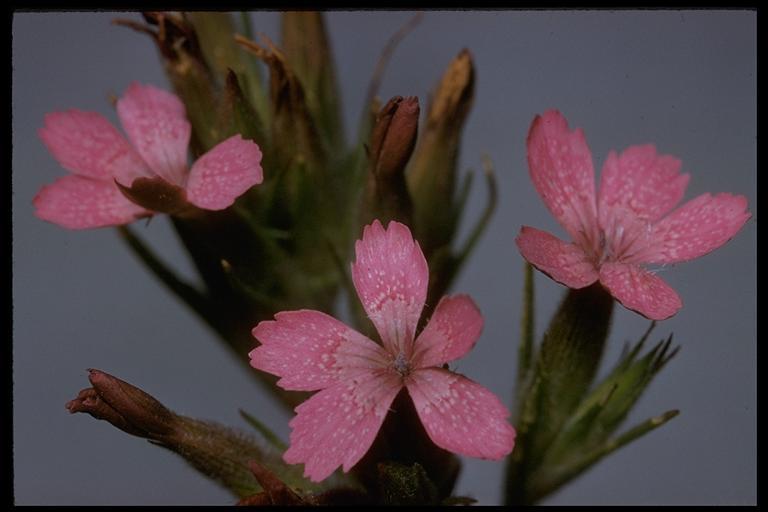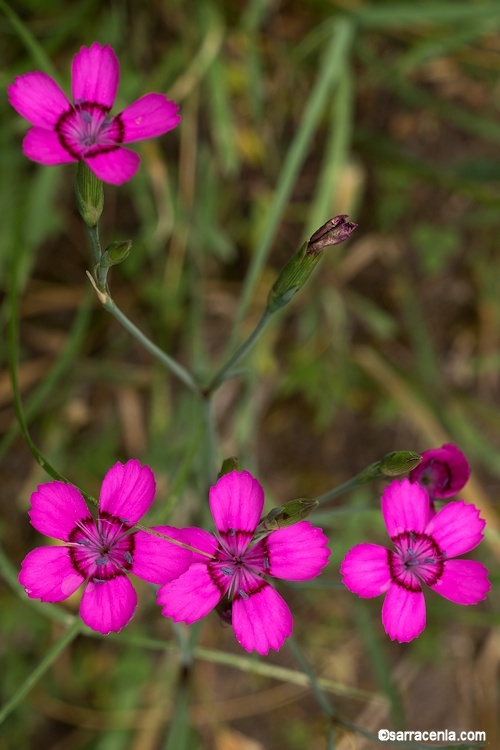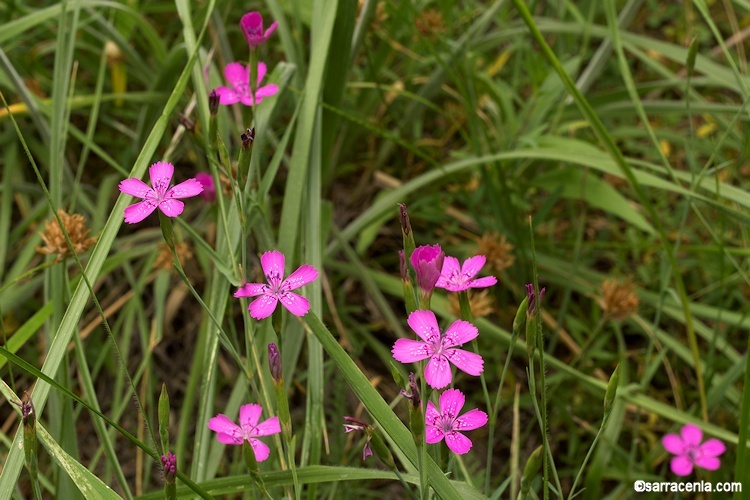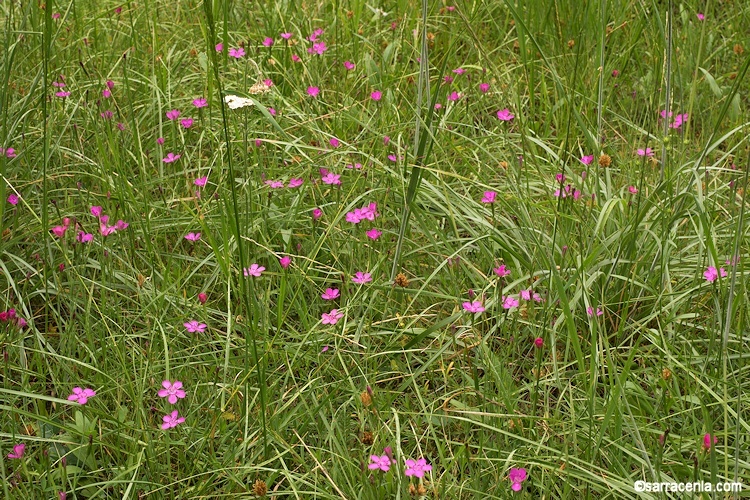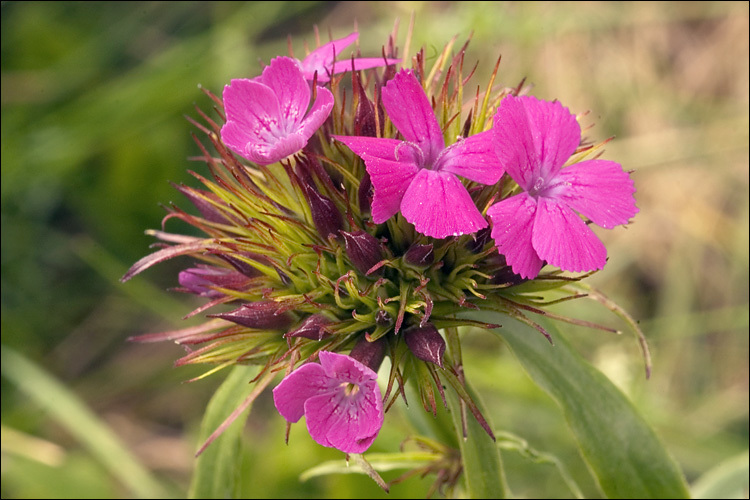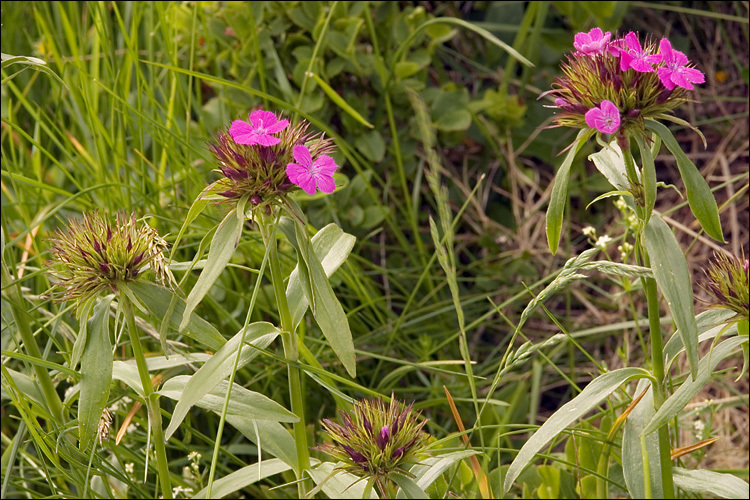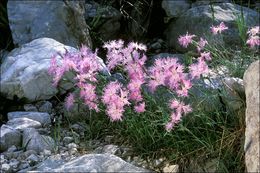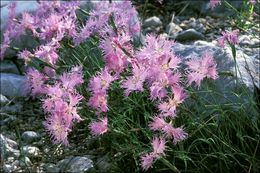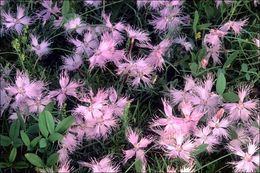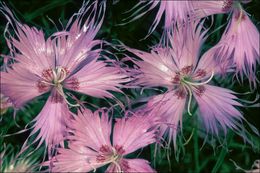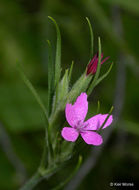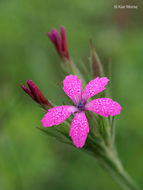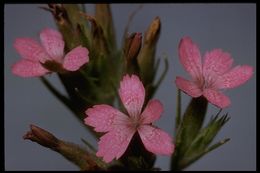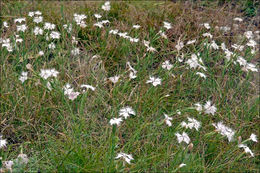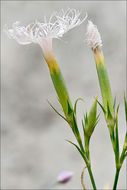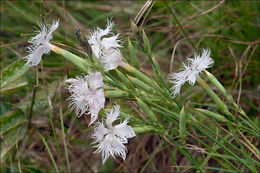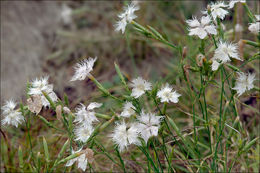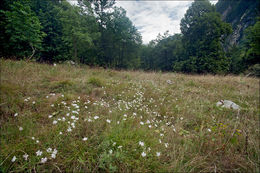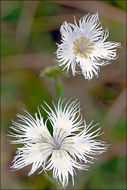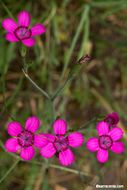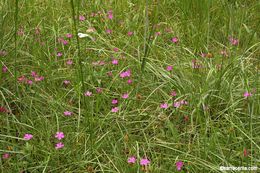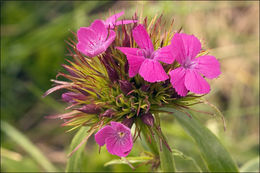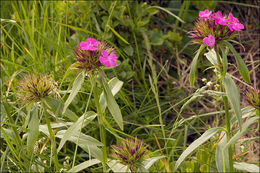-
Slo.: Sternbergov nageljcek
-
Slo.: Sternbergov nageljcek
-
Slo.: Sternbergov nageljcek
-
Slo.: Sternbergov nageljcek
-
-
-
-
1998 California Academy of Sciences
CalPhotos
-
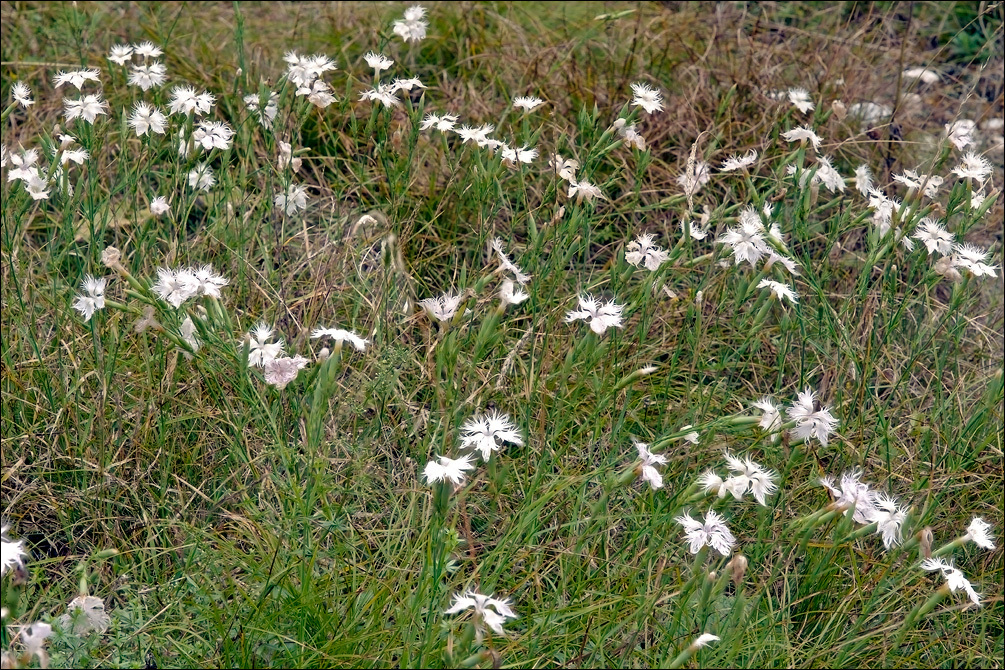
Slo.: montpellierski klinek, montpellierski nageljek - syn.: Dianthus monspessulanus L. subsp. monspessulanus, Dianthus monspessulanus L. - Habitat: grassland, former stony pasture; old overgrown colluvium, slightly southeast inclined slope; calcareous ground; dry, nutrients poor, shallow soil layer; sunny place, exposed to direct rain, average precipitations ~ 3.000 mm/year, average temperature 7-9 deg C, elevation 610 m (2.000 feet), alpine phytogeographical region. - Substratum: soil. - Comment: Species of genus Dianthus are beautiful and highly symbolic plants, particularly the red ones. They are symbol of love, courage, life, revolution and working class. Latin name of the genus is composed of two Greek words 'Dios' meaning god Zeus and 'anthos' meaning flower. All of them are pleasantly fragrant plants. Such is also Dianthus hyssopifolius even though their flowers lack vivid red color. It can be 'at best' pink and even this is not common in Slovenia, where most of the plants are almost white or only slightly pinkish. Nevertheless, their smell is wonderful and based on it they can be spotted from far even at night. The plant is not common, but also not rare in Slovenia. However, it is limited to western half of the country. In Austria and Switzerland it is considered as a rare plant. Otherwise, it is growing mostly in southern parts of the Alps in montane elevations, but sometimes it climbs up to 2.200 m elevation (Ref.:4). It can be found also in other European mountains. Dianthus hyssopifolius is usually found on dry, calcareous, nutrient poor meadows, sometimes also in light woods. - Protected according to: Uredba o zavarovanih prostoiveih rastlinskih vrstah, poglavje A, Uradni list RS, t. 46/2004 (Regulation on protected wild plants, chapter A, Official Gazette of Republic Slovenia, no. 46/2004), (2004). - Ref.: (1) A. Martini et all., Mala Flora Slovenije (Flora of Slovenia - Key) (in Slovenian), Tehnina Zaloba Slovenije (2007), p 187. (2) D. Aeschimann, K. Lauber, D.M. Moser, J.P. Theurillat, Flora Alpina, Vol. 1., Haupt (2004), p 358. (3) K. Lauber and G.Wagner, Flora Helvetica, 5. Auflage, Haupt (2012), p 670 (4) L. Fenaroli, Flora delle Alpi, Vegetazione e flora delle Alpi e degli altri monti d'Italia (1971), p 80. (5) M.A. Fischer, W. Adler, K. Oswald, Exkursionsflora fr sterreich, Liechtenstein und Sdtirol, LO Landesmuseen, Linz, Austria (2005), p 342.
-
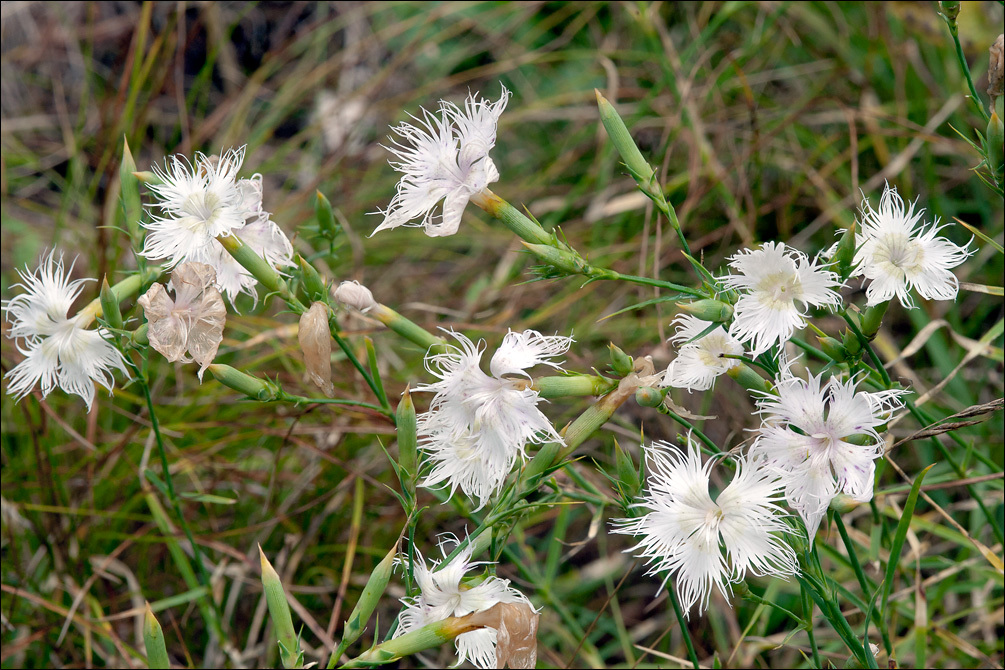
Slo.: montpellierski klinek, montpellierski nageljek - syn.: Dianthus monspessulanus L. subsp. monspessulanus, Dianthus monspessulanus L. - Habitat: grassland, former stony pasture; old overgrown colluvium, slightly southeast inclined slope; calcareous ground; dry, nutrients poor, shallow soil layer; sunny place, exposed to direct rain, average precipitations ~ 3.000 mm/year, average temperature 7-9 deg C, elevation 610 m (2.000 feet), alpine phytogeographical region. - Substratum: soil. - Comment: Species of genus Dianthus are beautiful and highly symbolic plants, particularly the red ones. They are symbol of love, courage, life, revolution and working class. Latin name of the genus is composed of two Greek words 'Dios' meaning god Zeus and 'anthos' meaning flower. All of them are pleasantly fragrant plants. Such is also Dianthus hyssopifolius even though their flowers lack vivid red color. It can be 'at best' pink and even this is not common in Slovenia, where most of the plants are almost white or only slightly pinkish. Nevertheless, their smell is wonderful and based on it they can be spotted from far even at night. The plant is not common, but also not rare in Slovenia. However, it is limited to western half of the country. In Austria and Switzerland it is considered as a rare plant. Otherwise, it is growing mostly in southern parts of the Alps in montane elevations, but sometimes it climbs up to 2.200 m elevation (Ref.:4). It can be found also in other European mountains. Dianthus hyssopifolius is usually found on dry, calcareous, nutrient poor meadows, sometimes also in light woods. - Protected according to: Uredba o zavarovanih prostoiveih rastlinskih vrstah, poglavje A, Uradni list RS, t. 46/2004 (Regulation on protected wild plants, chapter A, Official Gazette of Republic Slovenia, no. 46/2004), (2004). - Ref.: (1) A. Martini et all., Mala Flora Slovenije (Flora of Slovenia - Key) (in Slovenian), Tehnina Zaloba Slovenije (2007), p 187. (2) D. Aeschimann, K. Lauber, D.M. Moser, J.P. Theurillat, Flora Alpina, Vol. 1., Haupt (2004), p 358. (3) K. Lauber and G.Wagner, Flora Helvetica, 5. Auflage, Haupt (2012), p 670 (4) L. Fenaroli, Flora delle Alpi, Vegetazione e flora delle Alpi e degli altri monti d'Italia (1971), p 80. (5) M.A. Fischer, W. Adler, K. Oswald, Exkursionsflora fr sterreich, Liechtenstein und Sdtirol, LO Landesmuseen, Linz, Austria (2005), p 342.
-

Slo.: montpellierski klinek, montpellierski nageljek - syn.: Dianthus monspessulanus L. subsp. monspessulanus, Dianthus monspessulanus L. - Habitat: grassland, former stony pasture; old overgrown colluvium, slightly southeast inclined slope; calcareous ground; dry, nutrients poor, shallow soil layer; sunny place, exposed to direct rain, average precipitations ~ 3.000 mm/year, average temperature 7-9 deg C, elevation 610 m (2.000 feet), alpine phytogeographical region. - Substratum: soil. - Comment: Species of genus Dianthus are beautiful and highly symbolic plants, particularly the red ones. They are symbol of love, courage, life, revolution and working class. Latin name of the genus is composed of two Greek words 'Dios' meaning god Zeus and 'anthos' meaning flower. All of them are pleasantly fragrant plants. Such is also Dianthus hyssopifolius even though their flowers lack vivid red color. It can be 'at best' pink and even this is not common in Slovenia, where most of the plants are almost white or only slightly pinkish. Nevertheless, their smell is wonderful and based on it they can be spotted from far even at night. The plant is not common, but also not rare in Slovenia. However, it is limited to western half of the country. In Austria and Switzerland it is considered as a rare plant. Otherwise, it is growing mostly in southern parts of the Alps in montane elevations, but sometimes it climbs up to 2.200 m elevation (Ref.:4). It can be found also in other European mountains. Dianthus hyssopifolius is usually found on dry, calcareous, nutrient poor meadows, sometimes also in light woods. - Protected according to: Uredba o zavarovanih prostoiveih rastlinskih vrstah, poglavje A, Uradni list RS, t. 46/2004 (Regulation on protected wild plants, chapter A, Official Gazette of Republic Slovenia, no. 46/2004), (2004). - Ref.: (1) A. Martini et all., Mala Flora Slovenije (Flora of Slovenia - Key) (in Slovenian), Tehnina Zaloba Slovenije (2007), p 187. (2) D. Aeschimann, K. Lauber, D.M. Moser, J.P. Theurillat, Flora Alpina, Vol. 1., Haupt (2004), p 358. (3) K. Lauber and G.Wagner, Flora Helvetica, 5. Auflage, Haupt (2012), p 670 (4) L. Fenaroli, Flora delle Alpi, Vegetazione e flora delle Alpi e degli altri monti d'Italia (1971), p 80. (5) M.A. Fischer, W. Adler, K. Oswald, Exkursionsflora fr sterreich, Liechtenstein und Sdtirol, LO Landesmuseen, Linz, Austria (2005), p 342.
-
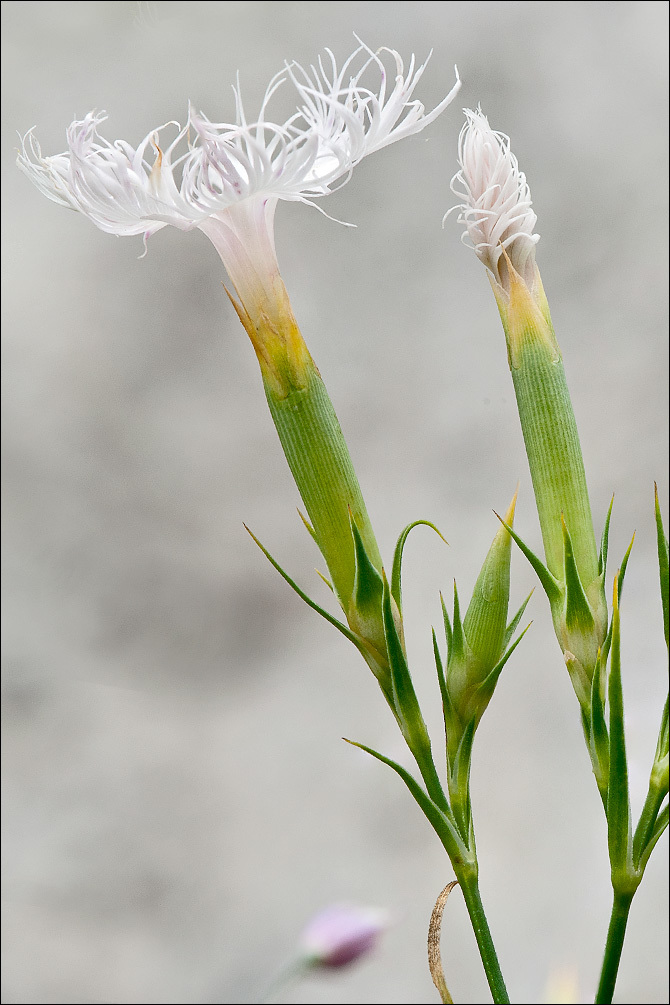
Slo.: montpellierski klinek, montpellierski nageljek - syn.: Dianthus monspessulanus L. subsp. monspessulanus, Dianthus monspessulanus L. - Habitat: grassland, former stony pasture; old overgrown colluvium, slightly southeast inclined slope; calcareous ground; dry, nutrients poor, shallow soil layer; sunny place, exposed to direct rain, average precipitations ~ 3.000 mm/year, average temperature 7-9 deg C, elevation 610 m (2.000 feet), alpine phytogeographical region. - Substratum: soil. - Comment: Species of genus Dianthus are beautiful and highly symbolic plants, particularly the red ones. They are symbol of love, courage, life, revolution and working class. Latin name of the genus is composed of two Greek words 'Dios' meaning god Zeus and 'anthos' meaning flower. All of them are pleasantly fragrant plants. Such is also Dianthus hyssopifolius even though their flowers lack vivid red color. It can be 'at best' pink and even this is not common in Slovenia, where most of the plants are almost white or only slightly pinkish. Nevertheless, their smell is wonderful and based on it they can be spotted from far even at night. The plant is not common, but also not rare in Slovenia. However, it is limited to western half of the country. In Austria and Switzerland it is considered as a rare plant. Otherwise, it is growing mostly in southern parts of the Alps in montane elevations, but sometimes it climbs up to 2.200 m elevation (Ref.:4). It can be found also in other European mountains. Dianthus hyssopifolius is usually found on dry, calcareous, nutrient poor meadows, sometimes also in light woods. - Protected according to: Uredba o zavarovanih prostoiveih rastlinskih vrstah, poglavje A, Uradni list RS, t. 46/2004 (Regulation on protected wild plants, chapter A, Official Gazette of Republic Slovenia, no. 46/2004), (2004). - Ref.: (1) A. Martini et all., Mala Flora Slovenije (Flora of Slovenia - Key) (in Slovenian), Tehnina Zaloba Slovenije (2007), p 187. (2) D. Aeschimann, K. Lauber, D.M. Moser, J.P. Theurillat, Flora Alpina, Vol. 1., Haupt (2004), p 358. (3) K. Lauber and G.Wagner, Flora Helvetica, 5. Auflage, Haupt (2012), p 670 (4) L. Fenaroli, Flora delle Alpi, Vegetazione e flora delle Alpi e degli altri monti d'Italia (1971), p 80. (5) M.A. Fischer, W. Adler, K. Oswald, Exkursionsflora fr sterreich, Liechtenstein und Sdtirol, LO Landesmuseen, Linz, Austria (2005), p 342.
-
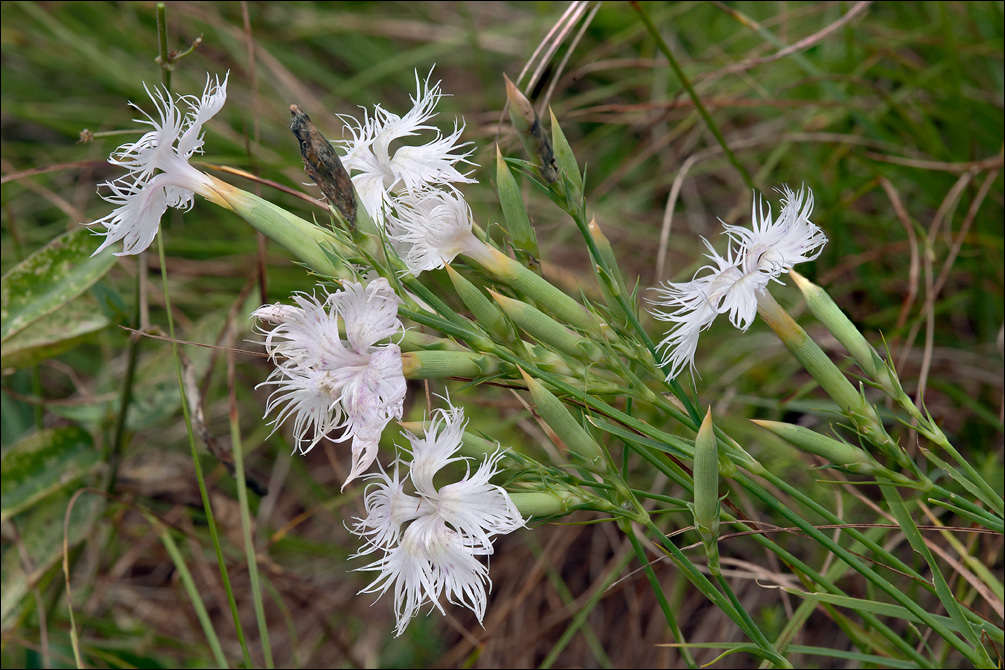
Slo.: montpellierski klinek, montpellierski nageljek - syn.: Dianthus monspessulanus L. subsp. monspessulanus, Dianthus monspessulanus L. - Habitat: grassland, former stony pasture; old overgrown colluvium, slightly southeast inclined slope; calcareous ground; dry, nutrients poor, shallow soil layer; sunny place, exposed to direct rain, average precipitations ~ 3.000 mm/year, average temperature 7-9 deg C, elevation 610 m (2.000 feet), alpine phytogeographical region. - Substratum: soil. - Comment: Species of genus Dianthus are beautiful and highly symbolic plants, particularly the red ones. They are symbol of love, courage, life, revolution and working class. Latin name of the genus is composed of two Greek words 'Dios' meaning god Zeus and 'anthos' meaning flower. All of them are pleasantly fragrant plants. Such is also Dianthus hyssopifolius even though their flowers lack vivid red color. It can be 'at best' pink and even this is not common in Slovenia, where most of the plants are almost white or only slightly pinkish. Nevertheless, their smell is wonderful and based on it they can be spotted from far even at night. The plant is not common, but also not rare in Slovenia. However, it is limited to western half of the country. In Austria and Switzerland it is considered as a rare plant. Otherwise, it is growing mostly in southern parts of the Alps in montane elevations, but sometimes it climbs up to 2.200 m elevation (Ref.:4). It can be found also in other European mountains. Dianthus hyssopifolius is usually found on dry, calcareous, nutrient poor meadows, sometimes also in light woods. - Protected according to: Uredba o zavarovanih prostoiveih rastlinskih vrstah, poglavje A, Uradni list RS, t. 46/2004 (Regulation on protected wild plants, chapter A, Official Gazette of Republic Slovenia, no. 46/2004), (2004). - Ref.: (1) A. Martini et all., Mala Flora Slovenije (Flora of Slovenia - Key) (in Slovenian), Tehnina Zaloba Slovenije (2007), p 187. (2) D. Aeschimann, K. Lauber, D.M. Moser, J.P. Theurillat, Flora Alpina, Vol. 1., Haupt (2004), p 358. (3) K. Lauber and G.Wagner, Flora Helvetica, 5. Auflage, Haupt (2012), p 670 (4) L. Fenaroli, Flora delle Alpi, Vegetazione e flora delle Alpi e degli altri monti d'Italia (1971), p 80. (5) M.A. Fischer, W. Adler, K. Oswald, Exkursionsflora fr sterreich, Liechtenstein und Sdtirol, LO Landesmuseen, Linz, Austria (2005), p 342.
-
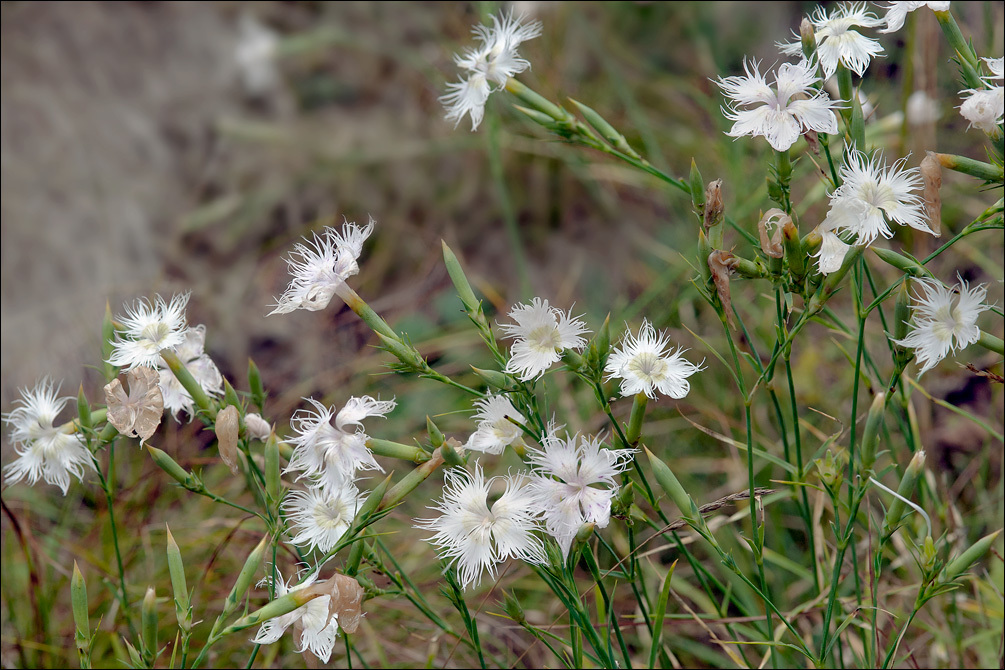
Slo.: montpellierski klinek, montpellierski nageljek - syn.: Dianthus monspessulanus L. subsp. monspessulanus, Dianthus monspessulanus L. - Habitat: grassland, former stony pasture; old overgrown colluvium, slightly southeast inclined slope; calcareous ground; dry, nutrients poor, shallow soil layer; sunny place, exposed to direct rain, average precipitations ~ 3.000 mm/year, average temperature 7-9 deg C, elevation 610 m (2.000 feet), alpine phytogeographical region. - Substratum: soil. - Comment: Species of genus Dianthus are beautiful and highly symbolic plants, particularly the red ones. They are symbol of love, courage, life, revolution and working class. Latin name of the genus is composed of two Greek words 'Dios' meaning god Zeus and 'anthos' meaning flower. All of them are pleasantly fragrant plants. Such is also Dianthus hyssopifolius even though their flowers lack vivid red color. It can be 'at best' pink and even this is not common in Slovenia, where most of the plants are almost white or only slightly pinkish. Nevertheless, their smell is wonderful and based on it they can be spotted from far even at night. The plant is not common, but also not rare in Slovenia. However, it is limited to western half of the country. In Austria and Switzerland it is considered as a rare plant. Otherwise, it is growing mostly in southern parts of the Alps in montane elevations, but sometimes it climbs up to 2.200 m elevation (Ref.:4). It can be found also in other European mountains. Dianthus hyssopifolius is usually found on dry, calcareous, nutrient poor meadows, sometimes also in light woods. - Protected according to: Uredba o zavarovanih prostoiveih rastlinskih vrstah, poglavje A, Uradni list RS, t. 46/2004 (Regulation on protected wild plants, chapter A, Official Gazette of Republic Slovenia, no. 46/2004), (2004). - Ref.: (1) A. Martini et all., Mala Flora Slovenije (Flora of Slovenia - Key) (in Slovenian), Tehnina Zaloba Slovenije (2007), p 187. (2) D. Aeschimann, K. Lauber, D.M. Moser, J.P. Theurillat, Flora Alpina, Vol. 1., Haupt (2004), p 358. (3) K. Lauber and G.Wagner, Flora Helvetica, 5. Auflage, Haupt (2012), p 670 (4) L. Fenaroli, Flora delle Alpi, Vegetazione e flora delle Alpi e degli altri monti d'Italia (1971), p 80. (5) M.A. Fischer, W. Adler, K. Oswald, Exkursionsflora fr sterreich, Liechtenstein und Sdtirol, LO Landesmuseen, Linz, Austria (2005), p 342.
-
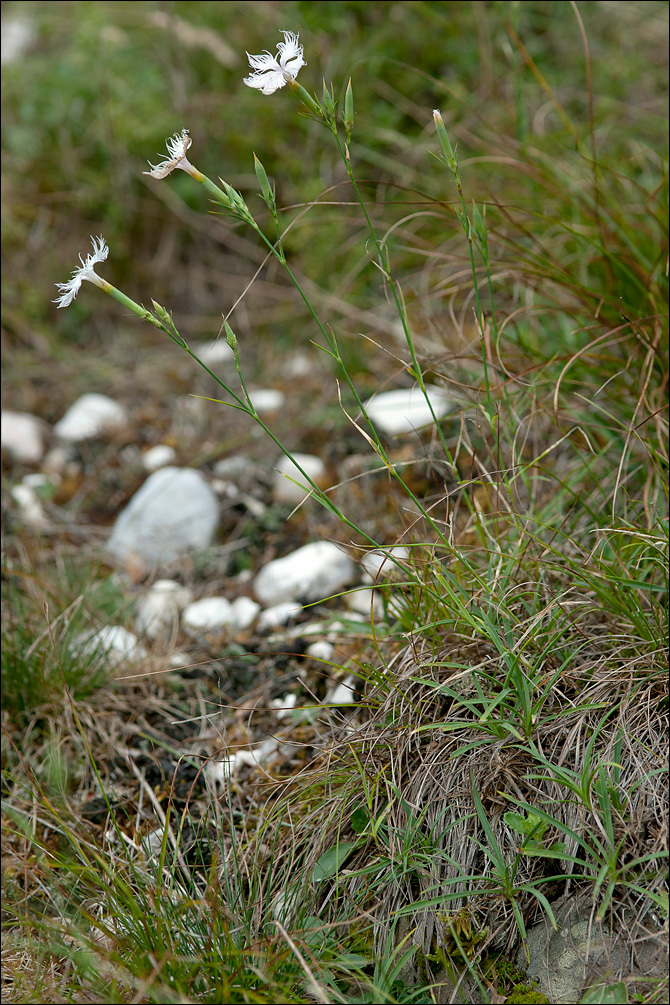
Slo.: montpellierski klinek, montpellierski nageljek - syn.: Dianthus monspessulanus L. subsp. monspessulanus, Dianthus monspessulanus L. - Habitat: grassland, former stony pasture; old overgrown colluvium, slightly southeast inclined slope; calcareous ground; dry, nutrients poor, shallow soil layer; sunny place, exposed to direct rain, average precipitations ~ 3.000 mm/year, average temperature 7-9 deg C, elevation 610 m (2.000 feet), alpine phytogeographical region. - Substratum: soil. - Comment: Species of genus Dianthus are beautiful and highly symbolic plants, particularly the red ones. They are symbol of love, courage, life, revolution and working class. Latin name of the genus is composed of two Greek words 'Dios' meaning god Zeus and 'anthos' meaning flower. All of them are pleasantly fragrant plants. Such is also Dianthus hyssopifolius even though their flowers lack vivid red color. It can be 'at best' pink and even this is not common in Slovenia, where most of the plants are almost white or only slightly pinkish. Nevertheless, their smell is wonderful and based on it they can be spotted from far even at night. The plant is not common, but also not rare in Slovenia. However, it is limited to western half of the country. In Austria and Switzerland it is considered as a rare plant. Otherwise, it is growing mostly in southern parts of the Alps in montane elevations, but sometimes it climbs up to 2.200 m elevation (Ref.:4). It can be found also in other European mountains. Dianthus hyssopifolius is usually found on dry, calcareous, nutrient poor meadows, sometimes also in light woods. - Protected according to: Uredba o zavarovanih prostoiveih rastlinskih vrstah, poglavje A, Uradni list RS, t. 46/2004 (Regulation on protected wild plants, chapter A, Official Gazette of Republic Slovenia, no. 46/2004), (2004). - Ref.: (1) A. Martini et all., Mala Flora Slovenije (Flora of Slovenia - Key) (in Slovenian), Tehnina Zaloba Slovenije (2007), p 187. (2) D. Aeschimann, K. Lauber, D.M. Moser, J.P. Theurillat, Flora Alpina, Vol. 1., Haupt (2004), p 358. (3) K. Lauber and G.Wagner, Flora Helvetica, 5. Auflage, Haupt (2012), p 670 (4) L. Fenaroli, Flora delle Alpi, Vegetazione e flora delle Alpi e degli altri monti d'Italia (1971), p 80. (5) M.A. Fischer, W. Adler, K. Oswald, Exkursionsflora fr sterreich, Liechtenstein und Sdtirol, LO Landesmuseen, Linz, Austria (2005), p 342.
-
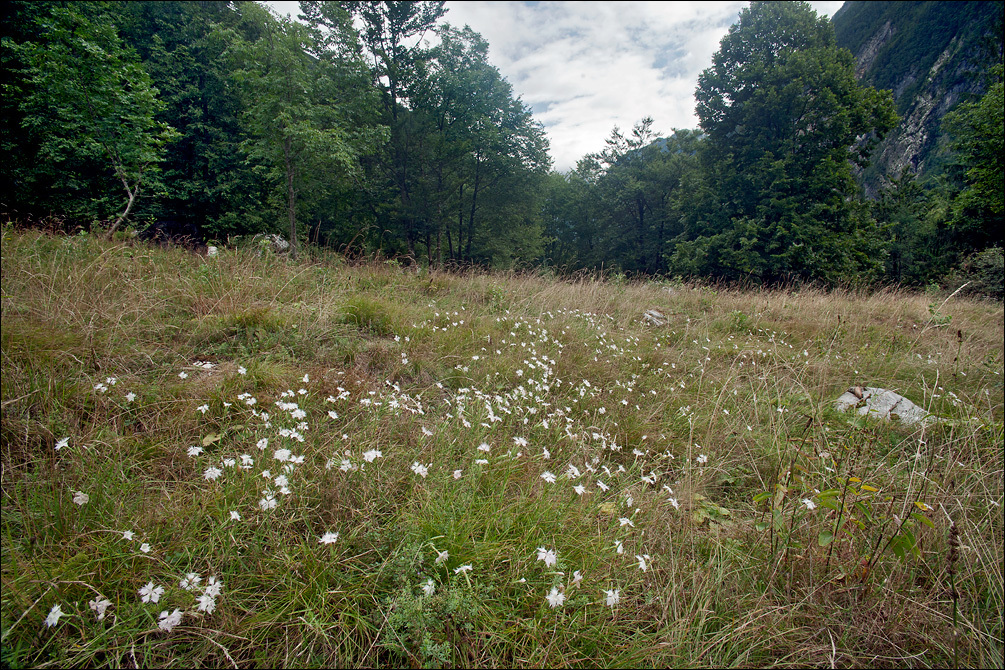
Slo.: montpellierski klinek, montpellierski nageljek - syn.: Dianthus monspessulanus L. subsp. monspessulanus, Dianthus monspessulanus L. - Habitat: grassland, former stony pasture; old overgrown colluvium, slightly southeast inclined slope; calcareous ground; dry, nutrients poor, shallow soil layer; sunny place, exposed to direct rain, average precipitations ~ 3.000 mm/year, average temperature 7-9 deg C, elevation 610 m (2.000 feet), alpine phytogeographical region. - Substratum: soil. - Comment: Species of genus Dianthus are beautiful and highly symbolic plants, particularly the red ones. They are symbol of love, courage, life, revolution and working class. Latin name of the genus is composed of two Greek words 'Dios' meaning god Zeus and 'anthos' meaning flower. All of them are pleasantly fragrant plants. Such is also Dianthus hyssopifolius even though their flowers lack vivid red color. It can be 'at best' pink and even this is not common in Slovenia, where most of the plants are almost white or only slightly pinkish. Nevertheless, their smell is wonderful and based on it they can be spotted from far even at night. The plant is not common, but also not rare in Slovenia. However, it is limited to western half of the country. In Austria and Switzerland it is considered as a rare plant. Otherwise, it is growing mostly in southern parts of the Alps in montane elevations, but sometimes it climbs up to 2.200 m elevation (Ref.:4). It can be found also in other European mountains. Dianthus hyssopifolius is usually found on dry, calcareous, nutrient poor meadows, sometimes also in light woods. - Protected according to: Uredba o zavarovanih prostoiveih rastlinskih vrstah, poglavje A, Uradni list RS, t. 46/2004 (Regulation on protected wild plants, chapter A, Official Gazette of Republic Slovenia, no. 46/2004), (2004). - Ref.: (1) A. Martini et all., Mala Flora Slovenije (Flora of Slovenia - Key) (in Slovenian), Tehnina Zaloba Slovenije (2007), p 187. (2) D. Aeschimann, K. Lauber, D.M. Moser, J.P. Theurillat, Flora Alpina, Vol. 1., Haupt (2004), p 358. (3) K. Lauber and G.Wagner, Flora Helvetica, 5. Auflage, Haupt (2012), p 670 (4) L. Fenaroli, Flora delle Alpi, Vegetazione e flora delle Alpi e degli altri monti d'Italia (1971), p 80. (5) M.A. Fischer, W. Adler, K. Oswald, Exkursionsflora fr sterreich, Liechtenstein und Sdtirol, LO Landesmuseen, Linz, Austria (2005), p 342.
-
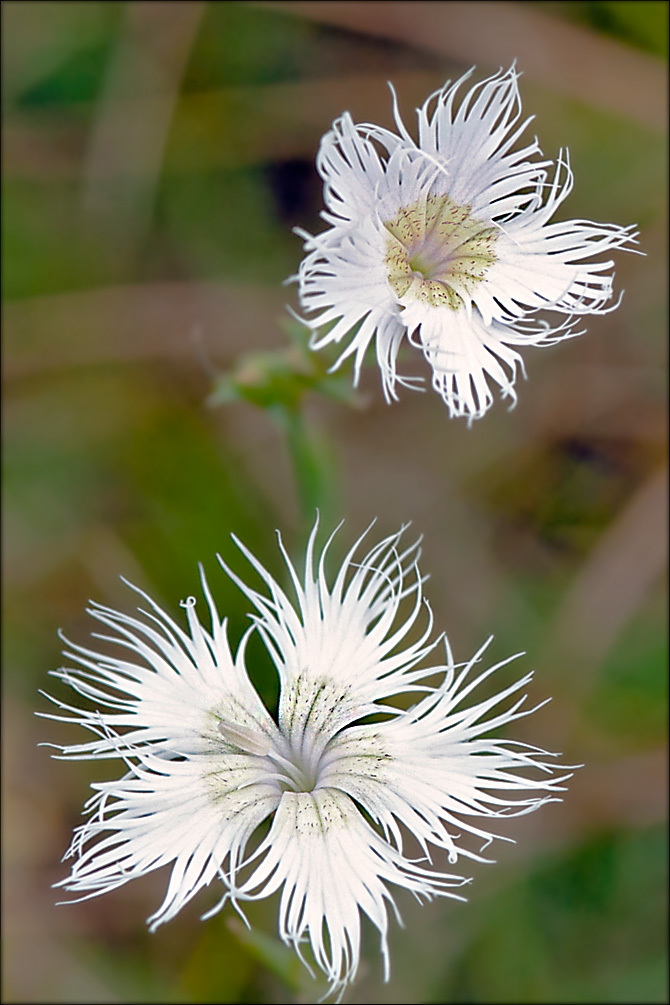
Slo.: montpellierski klinek, montpellierski nageljek - syn.: Dianthus monspessulanus L. subsp. monspessulanus, Dianthus monspessulanus L. - Habitat: grassland, former stony pasture; old overgrown colluvium, slightly southeast inclined slope; calcareous ground; dry, nutrients poor, shallow soil layer; sunny place, exposed to direct rain, average precipitations ~ 3.000 mm/year, average temperature 7-9 deg C, elevation 610 m (2.000 feet), alpine phytogeographical region. - Substratum: soil. - Comment: Species of genus Dianthus are beautiful and highly symbolic plants, particularly the red ones. They are symbol of love, courage, life, revolution and working class. Latin name of the genus is composed of two Greek words 'Dios' meaning god Zeus and 'anthos' meaning flower. All of them are pleasantly fragrant plants. Such is also Dianthus hyssopifolius even though their flowers lack vivid red color. It can be 'at best' pink and even this is not common in Slovenia, where most of the plants are almost white or only slightly pinkish. Nevertheless, their smell is wonderful and based on it they can be spotted from far even at night. The plant is not common, but also not rare in Slovenia. However, it is limited to western half of the country. In Austria and Switzerland it is considered as a rare plant. Otherwise, it is growing mostly in southern parts of the Alps in montane elevations, but sometimes it climbs up to 2.200 m elevation (Ref.:4). It can be found also in other European mountains. Dianthus hyssopifolius is usually found on dry, calcareous, nutrient poor meadows, sometimes also in light woods. - Protected according to: Uredba o zavarovanih prostoiveih rastlinskih vrstah, poglavje A, Uradni list RS, t. 46/2004 (Regulation on protected wild plants, chapter A, Official Gazette of Republic Slovenia, no. 46/2004), (2004). - Ref.: (1) A. Martini et all., Mala Flora Slovenije (Flora of Slovenia - Key) (in Slovenian), Tehnina Zaloba Slovenije (2007), p 187. (2) D. Aeschimann, K. Lauber, D.M. Moser, J.P. Theurillat, Flora Alpina, Vol. 1., Haupt (2004), p 358. (3) K. Lauber and G.Wagner, Flora Helvetica, 5. Auflage, Haupt (2012), p 670 (4) L. Fenaroli, Flora delle Alpi, Vegetazione e flora delle Alpi e degli altri monti d'Italia (1971), p 80. (5) M.A. Fischer, W. Adler, K. Oswald, Exkursionsflora fr sterreich, Liechtenstein und Sdtirol, LO Landesmuseen, Linz, Austria (2005), p 342.
-
-
-
-
Slo.: brkati klicek
-
Slo.: brkati klicek

